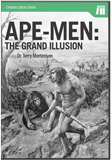
Sugar Molecules as Early Human Evolutionary Segregators
Sugary sialic acid signatures seen as evolutionary segregators of early humans
News Source
Cells must be recognized as “self” to avoid immune system attacks. The signatures of self are often sugar-like sialic acid molecules built into cell membranes. Those same signs also enable disease-causing pathogens to target species-specific attacks. Researchers from San Diego School of Medicine have proposed that ancient malaria attacks and immune-mediated infertility combined to separate early humans from ape ancestors.
The sialic signature on chimp cells is a molecule called Neu5Gc (N-glycolylneuranimic acid). The biochemical precursor of Neu5Gc is Neu5Ac, and Neu5Ac is the sialic signature on human cells. Many of the same genes are found in different types of organisms, and dramatic differences between organisms are sometimes attributable to the active or inactive status of various gene combinations. In this case, human cell membranes do not have Neu5Gc because the CMAH gene that codes for the enzyme involved in the final step of sialic synthesis is switched off.
The San Diego researchers maintain that the common ancestor of chimps and humans had Neu5Gc signatures. They point to previous studies suggesting that a CMAH mutation about two to three million years ago—about the time commonly assigned for the emergence of Homo erectus—produced a divergent population with a Neu5Ac signature.
Different forms of malaria attack chimps and humans. The chimp-type typically attacks red blood cells with the Neu5Gc signature, and the human-type attacks red blood cells with the Neu5Ac signature.1 Therefore, the researchers suggest that natural selection favoring the Neu5Ac hominid population in the face of an ancient chimp-type of malaria produced a population of early humans. Dr. Pascal Gagneux calls this phenomenon “speciation by infection.”
Ganneux’s group hypothesizes that this early human population became distinct because it was infertile whenever it mixed with the ancestral chimp-type ancestor. In essence, Gagneux’s group is proposing that early humans became “reproductively allergic” to the ancestral sialic cell marker. This immune system response would then cause some degree of infertility due to antibody attacks on sperm bearing ancestral sialic markers.
To explain how humans developed antibodies that attack the ancestral/chimp kind of sialic acid, Gagneux says, “This occurred at about the same time as early humans were apparently becoming major predators in their environment. It's hard to be sure exactly what happened because evolution works on so many things simultaneously, but the change in sialic acid meant that early humans developed an immune response to Neu5Gc. It became viewed by their immune systems as foreign, something to be destroyed. At about the same time, they started eating red meat, a major source of Neu5Gc, which may have further stimulated the immune response.”
Gagneux believes human immunity to Neu5Gc conveyed an evolutionary advantage to those diverging humans with the mutated marker, Neu5Ac. The reason? His team’s experiments show that human anti-Neu5Gc antibodies will attack and destroy chimp sperm in the laboratory. Also, their experiments with mice showed that mice immune to the sialic markers on mouse sperm were somewhat infertile. Thus, they believe that any ongoing in-breeding between early humans and other chimp-like hominids was unfruitful and that chimp-malaria weeded out any remaining hominids lacking the CMAH mutation.
“Over time, this incompatibility would reduce and then eliminate individuals with Neu5Gc,” Gagneux says. Co-author Dr. Ajit Varki concludes, “We suggest that the immune mechanism described here was involved in the origin of the genus Homo.”
So what are we to make of this? This study asserts that the earliest humans were animals interbreeding with ancestral apes until a lucky mutation conferring immunity to chimp-malaria culled the population, leaving the newly divergent group of early humans. It further asserts that these early humans experienced evolutionary success in their divergence because they developed immune-mediated infertility affecting mismatched matches.
The supposed chimp-human genomic similarity is overstated.
The supposed chimp-human genomic similarity is overstated. Even if the genomes were as similar as some assert—and those figures are based on gross oversimplifications and technological limitations—the “small” percentage of differences amounts to millions of differences. Furthermore, many additional differences arise due to regulatory “junk” DNA our common Designer built into genomes to utilize the same sets of designs and achieve radically different outcomes.
Beyond that, the three million year divergence time is based on the assumption that chimps and humans share a common ancestor—a direct contradiction of God’s statement (Genesis 1:26) that He made man distinct from the animals and in His own image. The three million years is calculated from molecular clock assumptions about how long it would take mutations to accumulate to produce a brand new creature. Yet mutations are a loss of information and cannot add up to make something new any more than a business can make up consistent losses by volume.
Finally, there are distinct differences between chimps and humans that extend far beyond what has been quantified in the genome. The dramatic physical and mental differences may derive in part from difference in the functions of so-called “junk DNA.” And the Bible makes it clear that God made man in His image, giving humans a spiritual dimension and enabling us by grace to have fellowship with our Creator.
The concept of “speciation by infection” is a reasonable mechanism by which a kind of organism could diversify. Furthermore, immune-mediated infertility is a real phenomenon affecting some human couples. However, neither of these concepts applies to the ape-human divergence since they in fact never had a common ancestor.
Further Reading
- Get Answers: Human Evolution
For More Information: Get Answers
Remember, if you see a news story that might merit some attention, let us know about it! (Note: if the story originates from the Associated Press, FOX News, MSNBC, the New York Times, or another major national media outlet, we will most likely have already heard about it.) And thanks to all of our readers who have submitted great news tips to us. If you didn’t catch all the latest News to Know, why not take a look to see what you’ve missed?
(Please note that links will take you directly to the source. Answers in Genesis is not responsible for content on the websites to which we refer. For more information, please see our Privacy Policy.)
Footnotes
- Maria J. Martin et al., “Evolution of human-chimpanzee differences in malaria susceptibility: Relationship to human genetic loss of N-glycolylneuraminic acid,” PNAS 102, no. 36 (September 6, 2005): 12819–12824, doi:10.1073/pnas.0503819102.
Recommended Resources

Answers in Genesis is an apologetics ministry, dedicated to helping Christians defend their faith and proclaim the good news of Jesus Christ.
- Customer Service 800.778.3390
- © 2024 Answers in Genesis






